► New E-Hybrids bring more power, longer electric range
► Same-again looks, big improvements beneath
► Includes new optional Active Ride suspension
The line-up of the latest Porsche Panamera has expanded with a new GTS model, as well as a flagship Turbo S E-Hybrid version.
Plug-in hybrids have accounted for the bulk of sales of this Porsche’s sales in recent years, driven by company car-friendly tax rates, and serving as an alternative to the dominating Taycan EV. So it’s no wonder Porsche is boosting the roster. The GTS trim, meanwhile, is designed as the sweet spot of performance and tech.
Give me the version lowdown
The Panamera’s range has a huge number of plug-in hybrids in it: 4 E-Hybrid and 4S E-Hybrid, Turbo E-Hybrid and now a flagship Turbo S E-Hybrid.
Go for a 4 or 4S and it uses a twin-turbo 2.9-litre V6 engine in an individual state of tune combined with a new, more powerful electric motor. On the 4 E-Hybrid, the combined outputs are 464bhp and 479lb ft of torque, with the 4S’s more powerful ICE helping to generate 537bhp and 553lb ft. Accelerating from 0-62mph takes 4.2 seconds and 3.7 seconds respectively.
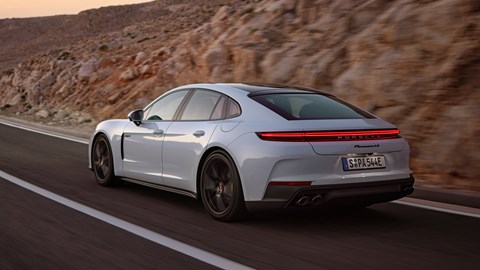
Porsche has also kitted the new Panamera out with a larger 25.9kWh battery with 45 per cent more capacity than before, with a claimed electric range of up to 59 miles.
Choose a Turbo or Turbo S E-Hybrid and you benefit from an electrified 4.0-litre V8. Turbo E-Hybrid generates 671bhp, equating to a dazzling 3.2-second 0-62mph time and 196mph top speed. The new flagship Turbo S E-Hybrid, which launched in July 2024, arrives with a mighty 771bhp and 738lb ft, good for a 2.9sec 0-62mph sprint and a top speed of 202mph.
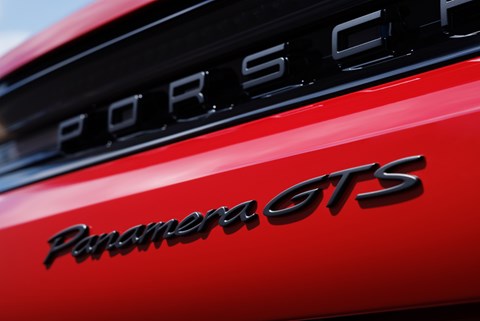
Don’t want a PHEV? The Panamera GTS uses a mild hybrid version of the V8 deployed with those Turbo cars, developing 493bhp and sprinting to 62mph in 3.8sec.
Doesn’t this new Panamera look similar to the old one?
It does, and we likely share your sentiment that it looks almost identical to the previous model. Despite that, Porsche’s VP for the Panamera model line, Thomas Friemuth, says it’s ‘a totally new Panamera.’
Emphasising the point, he adds: ‘The new front design is mainly characterised by being more athletic with more sharp lines. The side view you will see we have the option of centre-lock wheels, which is the first time here,’ adds Friemuth. And he’s right – Turbo models now feature centre-lock wheels that ape the brand’s various GT models elsewhere in the range.

There are new colours available, too, including this tasty orange pictured. ‘We’re working on our customers!’ Friemuth tells us when we discussed the expansion beyond sober blacks, greys and silvers usually seen with the Panamera; ‘we will try to learn to give our customers the opportunity to show some colour, not always grey.’
Friemuth also says that Porsche wants to do more to separate those who buy the hotter Turbo models. As well as those centre-lock wheels, Panamera Turbo models benefit from a more aggressive bodykit and the return of the triple-panel fold out rear wing. ‘The real big issue is what we call ‘Turbo differentiation’, this is new for Porsche,’ says Friemuth. ‘Our Turbo customers are special customers, and we now offer them differentiation which is not available for all the other customers.’
Part of that is the new ‘Turbonite’ colour scheme; a satin grey hue trimming various bits of the bodywork, as well as the interior. On top of that, Porsche has coloured its crest in Turbonite.
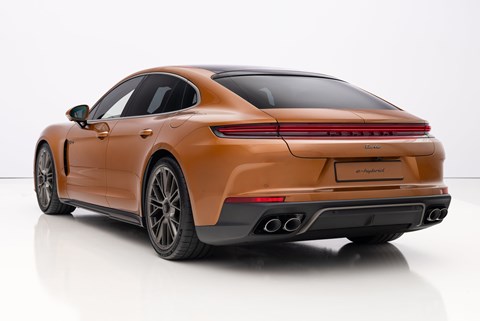
The cockpit has subtly evolved, too. The new ‘Porsche Driver Experience’ control layout might look rather familiar on first glance. Porsche’s classic GT steering wheel can be seen in the supplied pictures, and details directly in front of the driver include a curved instrument display and a shifter that’s been cloned from the Porsche Taycan.
A high centre console remains, complete with physical climate controls and volume dial – as well as what look like touch panel controls similar to the last generation. Again, like the Taycan, a passenger display can be seen inset into the dashboard – affording the front passenger more infotainment functionality for themselves.
A filter on the passenger screen that blocks the driver from seeing it, as with the latest Cayenne. A head-up display is an option, and the cockpit is filled with ambient lighting.

Porsche says that, as well as the gentle evolution of technology inside, the Panamera benefits from upgraded seat foam materials and additional upholster customisation options available when the car launches. A leather-free Race-Tex upholstery will be available for the first time in the Panamera, too.
On top of that, Porsche has confirmed the return of the Executive model available in certain markets that features a more spacious second row with newly-contoured seating. Rear passengers also benefit from a small touchscreen that runs along the centre console, too.
What if I don’t want a hybrid?
Fear not, as Porsche continues to sell a Panamera without any of this hybrid business.
Of course, Porsche doesn’t do ‘entry-level’ in the same way other carmakers do, with a 348bhp 2.9-litre twin-turbo V6 petrol engine being used in both the Panamera and Panamera 4. It’s essentially the 4 E-Hybrid but without the electric motor.
There is also the sporty GTS model with a much more potent V8, which Porsche claims is the ‘most agile’ version of the Panamera. As well as a SportDesign bodykit, the GTS is 10mm lower than a regular Panamera and features the brand’s Torque Vectoring Plus technology included as standard.
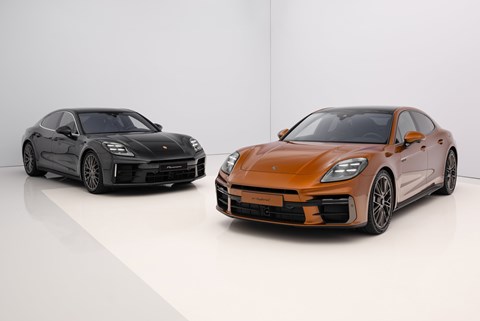
New Panamera models also benefit from two-chamber air suspension with two-valve dampers and a semi-active anti-roll bar (called PDCC Sport in Porsche code). You can also choose another, entirely different suspension system for E-Hybrid models: Active Ride.
What is Active Ride?
‘It’s a game-changer,’ Friemuth tells CAR.
The technology uses hydraulics and those two-valve dampers, and allows those models to tilt into corners or maintain an equilibrium when accelerating or braking hard. When you pull on the door handle (when getting in or out), the car’s ride height jumps up by 550mm for easier access.
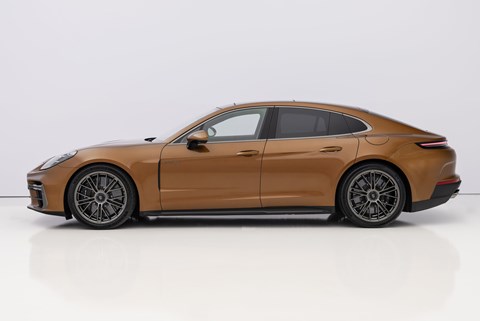
Naturally, it’s about stepping up the Panamera’s handling characteristics and improving the ride quality over the standard setup. So much so that Porsche says the system manages to be more comfortable, more refined and deliver unparalleled athleticism all at the same time.
Read our Panamera prototype review to find out what we think of Active Ride in action.
How much is a new-generation Porsche Panamera?
The range starts with the £79,500 Panamera, and it’ll be £3000 more if you want it as a ‘4’.
If you want the Panamera as a PHEV, the new 4 E-Hybrid and 4S E-Hybrid start from £90,300 and £102,100. The Turbo E-Hybrid, not surprisingly, commands quite the premium at £141,500. Even wealthier than that? The Turbo S E-Hybrid will set you back from £168,700.
After a Panamera Sport Turismo estate? You’re out of luck – this generation doesn’t get an estate model.